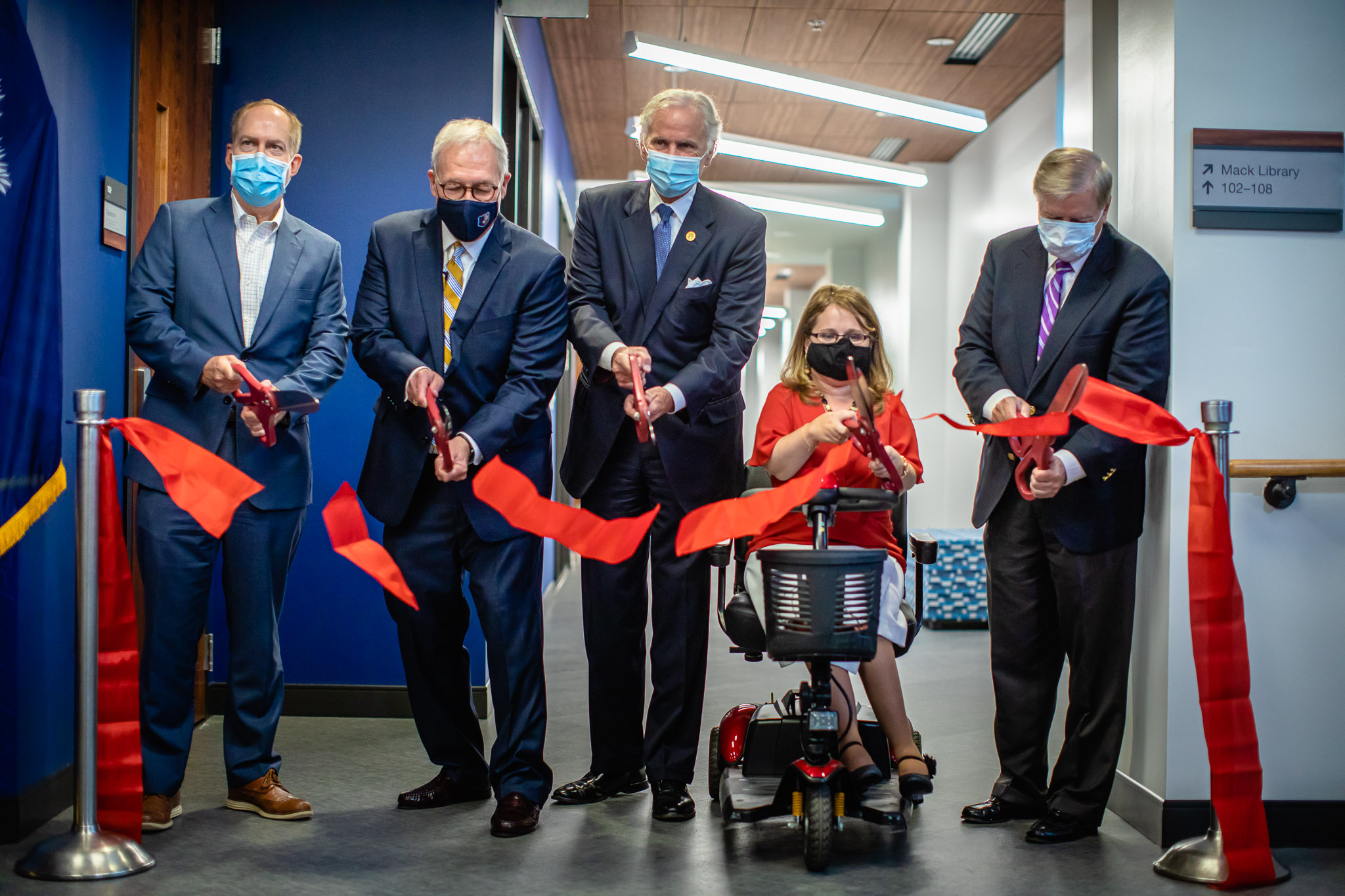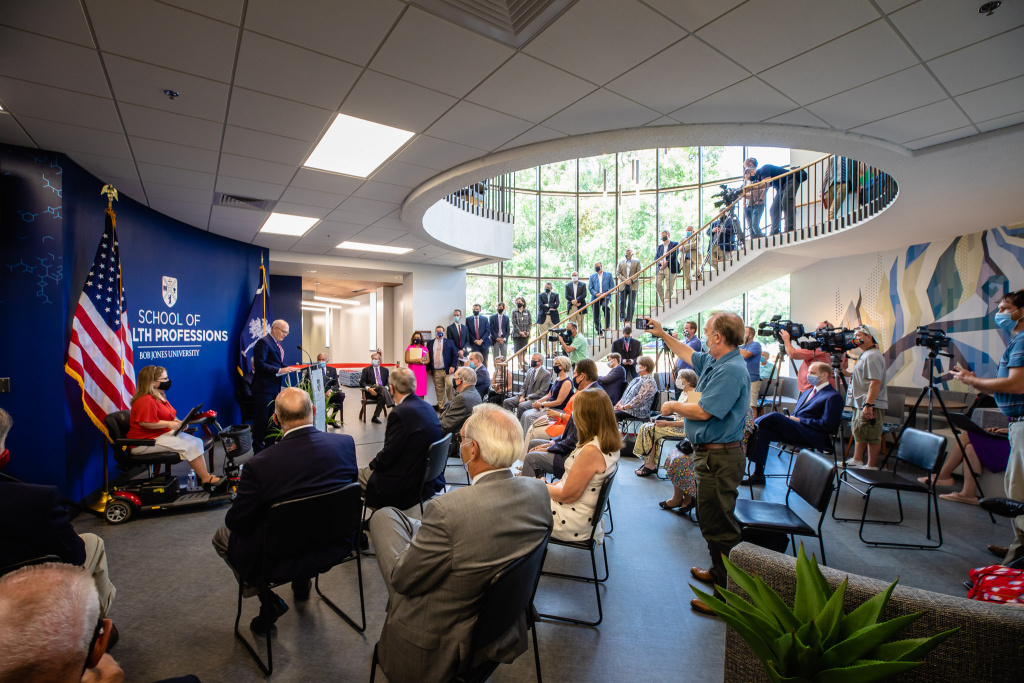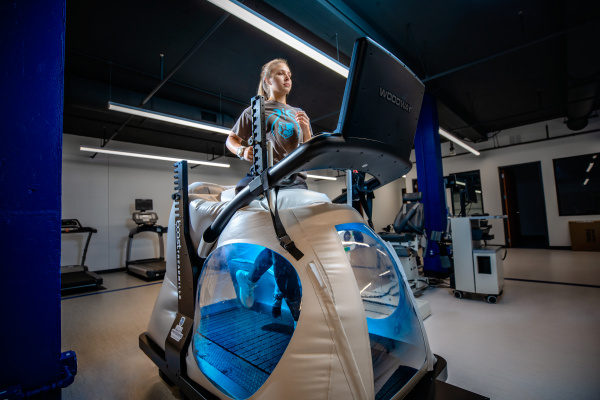U.S. Sen. Lindsey Graham jokingly lamented that he didn’t bring the proper attire to work out in the Wellness Lab during a tour of BJU’s School of Health Professions. He promptly was invited back any time.

Greenville Mayor Knox White, BJU President Steve Pettit, South Carolina Gov. Henry McMaster, School of Health Professions Dean Dr. Jessica Minor and U.S. Sen. Lindsey Graham cut the ribbon to open the School of Health Professions facility in the Mack Building.
Graham joined University administration, faculty and staff — along with other dignitaries including South Carolina Gov. Henry McMaster, Greenville Mayor Knox White and Dr. John Lewis, chairman of the BJU Board of Trustees — to officially open the School of Health Professions, which will have a long-term influence on the preparation of Christian health care professionals in increasingly important and complex fields.
“I just turned 65, I’m a Baby Boomer, so get as many graduates out as soon as you can,” Graham said. “To those men and women who go through this facility and graduate, you’ll be doing yourself, your state and your country a great service. I can’t think of a better thing to do to help mankind than to go into health care professions.
“The thing that I like most about this university is you know who you are and what you believe. And that’s important in difficult and troubling times.”
Geared for Growth
The 28,000-square-foot facility on the ground floor of the Mack Building houses state-of-the-art experiential labs and classrooms for 10 undergraduate academic programs with seven concentrations. Additionally, co-locating the Division of Nursing, Division of Exercise and Sport Science and the Division of Health Sciences in the airy and functional space will promote collaboration among disciplines, enrollment growth and community engagement.
“The School of Health Professions is dedicated to preparing students for a changing and often chaotic world of health,” said Dr. Jessica Minor, dean of the School of Health Professions. “From growth and career preparation with additional hands-on equipment as well as skills in the labs, I see those as being key. And then we’ll have the collaboration between all three divisions. We are constantly looking for ways to improve our students’ education and learning environment.”
Formation of the School of Health Professions was announced in January 2018 and opened for the 2018–2019 academic year. In the two years, it has become the University’s fastest-growing school with 520 students. For the fall semester that begins Aug. 18 on campus, 160 new students will be attending classes in their major in the building.
See Also: Programs of Study
“Last year we were at our capacity in all of our buildings and all of our programs, so it was going to be a limiting factor soon. We are accessing growth in all programs already even for next year,” Minor added. “From a long-term perspective, we’ll focus on additional programs as well as focusing on community engagement.”
Features of the Facility
School of Health Professions faculty worked with Greenville architectural firm LS3P to design the footprint for functional, intuitive spaces and long-term needs.
“One of our main goals was to bring our health care programs into a single, collaborative environment which would mimic real-life health care,” BJU President Steve Pettit said. “Health care is increasingly team-based, and this facility will encourage team-based thinking. Collaboration will be intentional and purposeful.”
Renovation of the two-story building began in summer 2019, with the library consolidated on the second floor for the 2019–20 academic year. The Jerusalem Chamber, which houses a collection of rare Bibles, and the Archives Memorabilia Room remain open to the public on the first floor.
The School of Health Professions space includes:
- A 14-bed nursing skills lab that simulates a hospital floor for the aid in teaching multidisciplinary skills necessary in evaluating patients and providing care.
- Labs for four high-fidelity patient simulators with corresponding control/observation rooms for the aid in teaching skills pertaining to cardiac, circulation, airway and breathing management.
- A Human Performance Lab that includes a classroom, state-of-the-art equipment and tools to test all aspects of health, fitness and sports performance.
- A Wellness Lab with equipment designed for students to learn how to meet people’s needs in health, fitness and recreation.
- Communication disorders clinical instruction rooms and workstations.
- Three lecture rooms that will accommodate more than 200 students in total.
- Collaborative workspaces.
- Faculty offices, conference rooms and lounge areas.
- Space for incorporating new programs or other labs.
A private/public capital campaign to meet the $5.75 million goal of the project was completed during the University’s 2019–20 fiscal year. Tax-deductible gifts to supply equipment and future needs can be made at give.bju.edu/donate.
“We are excited to see what God has done for us. It is for students to not just get a place of spiritual growth but a high-quality education. All the labs and classrooms, just what a fantastic addition for the school,” said Dr. Stephen Chen, division chair, Division of Exercise and Sport Science. “We hope it will help us to grow and through the years progress and develop graduate programs. We’re excited to work together to further our mission and this facility is part of that.”
Importance of Health Care Programs
Health care occupations overall are expected to grow 19% by 2024 — outpacing all other occupations by double digits, according to the U.S. Bureau of Labor Statistics. An aging U.S. population requiring varying levels of care is a main component driving health care profession opportunities.
“We are proud of our students and what they are accomplishing in the health care world,” Pettit said. “Ninety-seven percent of our nursing graduates will pass the capstone exam the first time, which is outpacing national and South Carolina pass rates. Eighty to 100 percent of our premed graduates are accepted into med school within one year of graduation. We say here if you can pass premed at Bob Jones University you will get into med school.
“The University’s mission is at the very core of what we are doing because we have a goal. We believe health care is rooted in the nature of the Gospel of Jesus Christ, who was not only a preacher and a teacher but he was healing people as he went about doing good. Following Christ’s example of compassionately caring for those with physical needs as the first step to meeting their spiritual needs is at the core of what we’re trying to accomplish.
“Bob Jones University loves Greenville, and we want to continue to contribute to the well-being of the Greenville community. And one way we can do that is to make sure that we have quality health care. We will use this new facility to continue to supply the best-prepared graduates possible, many of whom will become outstanding participants in the Greenville health care community.”
Watch the School of Health Professions facility ribbon cutting ceremony below:








